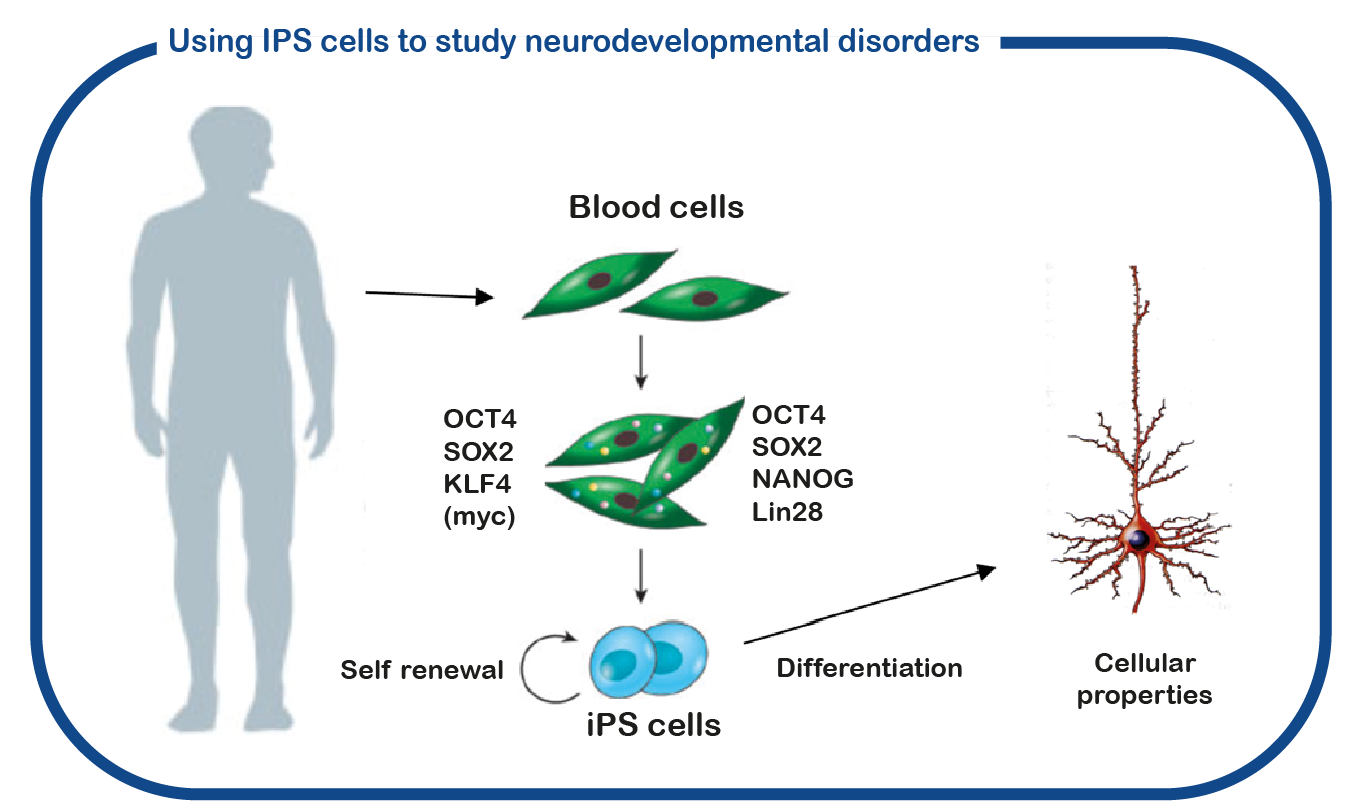Monozygotic (‘identical’) twin studies have shown that autism is highly heritable. In the last decade, many genes have been identified which, when mutated, can cause autism. A comprehensive list of these ‘autism’ genes is shown below (source: www.SFARI.org; updated January, 2020).

Many of the neurodevelopmental disorders that are part of the ENCORE expertise center are associated with autism, and hence they are on the ‘autism’ gene list as shown above (e.g. UBE3A, TSC, FMR1, GRIN, most RASopathies). However, there are also many genes on this list for which patients are ultra-rare, with only 1 or a few patients in The Netherlands. To learn from these disorders, understand their differences and investigate options for treatment, we have started the ‘Unique’ (‘Uniek’) expertise center. In the lab we study these disorders using induced pluripotent stem (iPS) cells. These stem cells are generated from reprogrammed blood cells donated by patients and unaffected family members. The major benefit of such iPS cells is that we can differentiate these cells into human neurons, which enables us to study human (patient) neurons in a dish. With this approach we hope to decipher how these mutations cause neuronal dysfunction and identify novel drugs to correct neuronal function.

Albuainain F, et.al. (2024) Confirmation and expansion of the phenotype of the TCEAL1-related neurodevelopmental disorder. Eur J Hum Genet. Pubmed
Heimer G, et al. (2020) Netrin-G2 dysfunction causes a Rett-like phenotype with areflexia. Hum Mutat 41, 476–86. Pubmed
Kumar R, et al. (2020) Expanding Clinical Presentations Due to Variations in THOC2 mRNA Nuclear Export Factor. Front Mol Neurosci. 13,1-15. Pubmed
de Vrij FM, et al. (2019) Candidate CSPG4 mutations and induced pluripotent stem cell modeling implicate oligodendrocyte progenitor cell dysfunction in familial schizophrenia. Mol Psychiatry. 24; 757–71. Pubmed
White T, et al. (2018) Paediatric population neuroimaging and the Generation R Study: the second wave. Eur J Epidemiol. 33; 99–125. Pubmed
Bruinsma CF, et al. (2015) An essential role for UBE2A/HR6A in learning and memory and mGLUR-dependent long-term depression. Hum Mol Genet. 25; 1-8. Pubmed
Eussen, M.L. et al. (2013) The association of quality of social relations, symptom severity and intelligence with anxiety in children with autism spectrum disorders. Autism 17, 723–735. Pubmed
Marroun, El, H. et al. (2013) Prenatal Tobacco Exposure and Brain Morphology: A Prospective Study in Young Children. Neuropsychopharmacology. Pubmed
Louwerse, A. et al. (2013) Autonomic Responses to Social and Nonsocial Pictures in Adolescents With Autism Spectrum Disorder. Autism Res. Pubmed
So, P. et al. (2013) Using the Child Behavior Checklist and the Teacher’s Report Form for identification of children with autism spectrum disorders. Autism 17, 595–607. Pubmed
Román, G.C. et al. (2013) Association of gestational maternal hypothyroxinemia and increased autism risk. Ann Neurol. Pubmed
Greaves-Lord, K. et al. (2013) Empirically based phenotypic profiles of children with pervasive developmental disorders: interpretation in the light of the DSM-5. J Autism Dev Disord 43, 1784–1797. Pubmed
White, T. et al. (2013) Pediatric population-based neuroimaging and the Generation R Study: the intersection of developmental neuroscience and epidemiology. Eur. J. Epidemiol. 28, 99–111. Pubmed
Jaspers, M. et al. (2013) Early childhood assessments of community pediatric professionals predict autism spectrum and attention deficit hyperactivity problems. J Abnorm Child Psychol 41, 71–80. Pubmed
Baudouin, S.J. et al. (2012) Shared synaptic pathophysiology in syndromic and nonsyndromic rodent models of autism. Science 338, 128–132. Pubmed
van der Vlugt, J.J.B. et al. (2012) Cognitive and behavioral functioning in 82 patients with trigonocephaly. Plast. Reconstr. Surg. 130, 885–893. Pubmed
Hermans, H. et al. (2012) Feasibility, reliability and validity of the Dutch translation of the Anxiety, Depression And Mood Scale in older adults with intellectual disabilities. Res Dev Disabil 33, 315–323. Pubmed
Vuijk, R. et al. (2012) Personality traits in adults with autism spectrum disorders measured by means of the Temperament and Character Inventory. Tijdschr Psychiatr 54, 699–707. Pubmed
Nijmeijer, J.S. et al. (2010) Perinatal risk factors interacting with catechol O-methyltransferase and the serotonin transporter gene predict ASD symptoms in children with ADHD. J Child Psychol Psychiatry 51, 1242–1250. Pubmed
Tiemeier, H. et al. (2010) Cerebellum development during childhood and adolescence: a longitudinal morphometric MRI study. Neuroimage 49, 63–70. Pubmed
de Bruin, E.I. et al. (2009) Autistic features in girls from a psychiatric sample are strongly associated with a low 2D:4D ratio. Autism 13, 511–521. Pubmed
Herba, C.M. et al. (2008) Face and emotion recognition in MCDD versus PDD-NOS. J Autism Dev Disord 38, 706–718. Pubmed
de Bruin, E.I. et al. (2007) Multiple complex developmental disorder delineated from PDD-NOS. J Autism Dev Disord 37, 1181–1191. Pubmed
de Bruin, E.I. et al. (2007) High rates of psychiatric co-morbidity in PDD-NOS. J Autism Dev Disord 37, 877–886. Pubmed
de Bruin, E.I. et al. (2006) Differences in finger length ratio between males with autism, pervasive developmental disorder-not otherwise specified, ADHD, and anxiety disorders. Dev Med Child Neurol 48, 962–965. Pubmed
de Bruin, E.I. et al. (2006) WISC-R subtest but no overall VIQ-PIQ difference in Dutch children with PDD-NOS. J Abnorm Child Psychol 34, 263–271. Pubmed
Dekker, M.C. et al. (2002) Assessing emotional and behavioral problems in children with intellectual disability: revisiting the factor structure of the developmental behavior checklist. J Autism Dev Disord 32, 601–610. Pubmed
van der Geest, J.N. et al. (2002) Gaze behavior of children with pervasive developmental disorder toward human faces: a fixation time study. J Child Psychol Psychiatry 43, 669–678. Pubmed
van der Geest, J.N. et al. (2002) Looking at images with human figures: comparison between autistic and normal children. J Autism Dev Disord 32, 69–75. Pubmed
